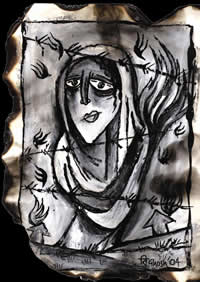
Over this past weekend there was an article published in the Los Angeles Times of the experiences of Sikh women and maintaining kesh. This article addresses the journey and relationship with kesh, looking at societal pressures as well as a personal journey, and in this case, it happened to be my journey. The article idea was born out of a series of conversations I had with a reporter with the LA Times. I would also like to reiterate that this article is not about me as a representative of any Sikh organization I am part of.
Most of the feedback I have received has been complimentary, though some has been accusatory and judgmental. For all the commentary: Thank you for time, the words, and the emotions—whether I agree with it or not. My major concern, however, does not come from the extremely personal nature of the story you read, it comes from the fact that I felt misrepresented, and the issue highlighted was misrepresented. The last 48 hours or so I have been thinking about why, and that is what I would like to share.
My major concern is that the entire concept of hair removal is framed around men and marriage. This is problematic. Whereas the overall idea of double-standards concerning men and women is not a new one—I do not believe that there is only one person, or gender to blame. Perhaps it is what manifests as the topical problem, but the issues around hair removal and Sikh women are not, and should not be limited to this scope. My journey and struggles with my kesh seem to be conveniently minimized to be about men. The androcentric way that the issue of hair removal solely exists in a space with men and marriage is demeaning and incorrect as a reflection of my personal journey.
Each year, SikhNet hosts an online youth film festival – to cultivate interest from Sikh filmmakers from around the globe. The online film festival is an excellent way for individuals to dialogue about issues affecting us personally and as a community. One of the films, titled Khalsa Has No Gender, is made by a group of young teen-aged Sikh women living in England and the goal of the film is to address gender [in]equality within our community. The film was striking to me for several reasons. Firstly, that these young women chose to use the medium of film to discuss this very important issue and secondly, that the concept of gender discrimination and inequality is prevalent in the conscience of very young Sikhs – Sikhs who are perhaps even 3rd and 4th generational living in the disapora.
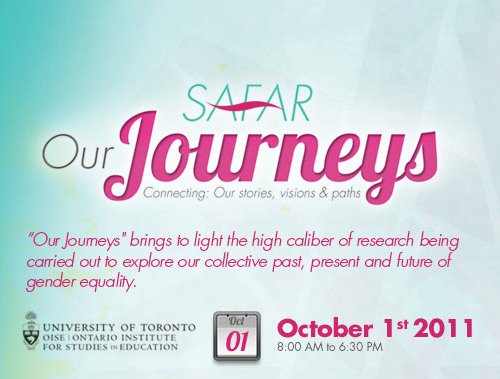 While on one hand it’s disheartening to acknowledge that perhaps change is slower than we have hoped it to be (displayed by the film), there is – on the other hand – reason to be optimistic. In just over a week, scholars and community members from across the globe are gathering in Toronto for the very first Sikh Feminist Conference, “Our Journeys”, hosted by the Sikh Feminist Research Institute (SAFAR).
While on one hand it’s disheartening to acknowledge that perhaps change is slower than we have hoped it to be (displayed by the film), there is – on the other hand – reason to be optimistic. In just over a week, scholars and community members from across the globe are gathering in Toronto for the very first Sikh Feminist Conference, “Our Journeys”, hosted by the Sikh Feminist Research Institute (SAFAR).
[Our Journeys is] an opportunity for scholars and community members alike to openly connect, converse and engage in a dialogue and critical thinking about gender related issues that demand to be voiced, and heard, in order to be addressed.
The line up of topics and speakers is remarkable. The keynote speaker, Professor Nikky-Guninder Kaur Singh is well known for introducing the term “Sikh feminism” and will share a Panel with Geetanjali Singh Chanda and Mallika Kaur to explore how Sikh feminism is defined, its origins, the present-day reality and how it can be an impetus for social change.
The issue of sex-selective abortion is not new here in The Langar Hall. A number of our bloggers have commented on this complex issue in the past; and even early community initiatives have been supported as well.
Recently I saw the official trailer of a documentary – It’s A Girl – that promises to look at the issue in China and India.
In India, China and many other parts of the world today, girls are killed, aborted and abandoned simply because they are girls. The United Nations estimates as many as 200 million girls(1) are missing in the world today because of this so-called “gendercide”.
Shot on location in India and China, It’s a Girl! explores the issue. It asks why this is happening, and why so little is being done to save girls and women.
The film tells the stories of abandoned and trafficked girls, of women who suffer extreme dowry-related violence, of brave mothers fighting to save their daughters’ lives, and of other mothers who would kill for a son. Global experts and grassroots activists put the stories in context and advocate different paths towards change, while collectively lamenting the lack of any truly effective action against this injustice.
Currently in post-production, It’s a Girl! is scheduled for an early 2012 release.
I invite our readers to take a look at the trailer and share their comments, as will I.

Along with the start of the holy month of Ramadan, the last few weeks have seen an increase in momentum for laws that ban the wearing of the burqa and niqab in European 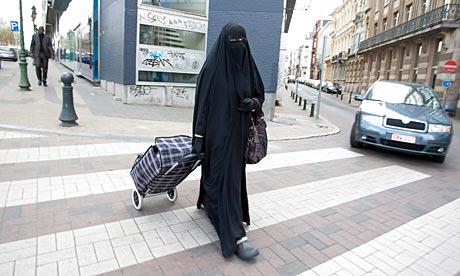 countries. We’ve talked about France before, where the implementation of its law banning Muslim face covering began this past spring. Now Belgium, which passed a similar measure last year, has begun implementing its ban on burqas as of July 23rd, and in Italy, new anti-burqa legislation was just passed by a parliamentary commission this week.
countries. We’ve talked about France before, where the implementation of its law banning Muslim face covering began this past spring. Now Belgium, which passed a similar measure last year, has begun implementing its ban on burqas as of July 23rd, and in Italy, new anti-burqa legislation was just passed by a parliamentary commission this week.
In both countries, like France, a miniscule number of women actually wear the burqa or niqab, begging the question of why an increasing number of European nations feel so threatened by it.
In Belgium, the lawmaker who proposed the bill, Daniel Bacquelaine, “said it was necessary to forbid the wearing of clothes that ‘totally mask and enclose’ the wearer. He described wearing the burqa as ‘not compatible with an open, liberal, tolerant society.’ Peter DeDecker of the Flemish separatist NVA saw the ban as a way of defending ‘our fundamental principles of the enlightenment.'”
Just as in France, what I would argue (and have previously argued) is an attack on religious freedom is being justified with the rhetoric of freedom and liberty (and public safety).
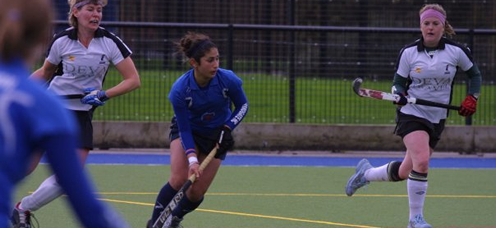
Ashpal Kaur Bhogal
TLH has covered several promising athletes in the Sikh community. Basketball player Darsh Singh, Football player Nuvraj Bassi, and Boxer Andrew Singh Kooner. The list of Sikh athletes is fortunately growing, including Fauja Singh, Pardeep Nagra, and Subaig Singh – some of whom we have covered and others we haven’t had a chance to. Jodha recently updated us on the Bhullar Brothers, potential NBA-ers, Sim Bhullar and younger brother Tanveer Bhullar, both 7-foot-somethings.
The thing about this list, however, is that all of these athletes are men.
It begs the question, then, where is the representation of Kaurs in sports today? After watching news coverage of the growing number of women playing kabaddi in Punjab, and with the popularity of the Women’s World Cup finals this past weekend, it made me think about the importance of sports in the lives of young Sikh girls. Much has been written about why sports are critical for young girls.
A large body of research shows that sports are associated with all sorts of benefits, like lower teenage pregnancy rates, better grades and higher self-esteem… separate studies from two economists offer some answers, providing the strongest evidence yet that team sports can result in lifelong improvements to educational, work and health prospects… Using a complex analysis, Dr. Stevenson showed that increasing girls’ sports participation had a direct effect on women’s education and employment. [link]
Guest blogged by Neesha Meminger
Admin note: In an effort to further cultivate the conversation on Faith and Feminism within the Sikh community, panelists from the Open Heart/Closed Fist event in NYC will share their thoughts with us. To learn more about the panel, please read Sikh Women Speak Out on Faith and Feminism.
::
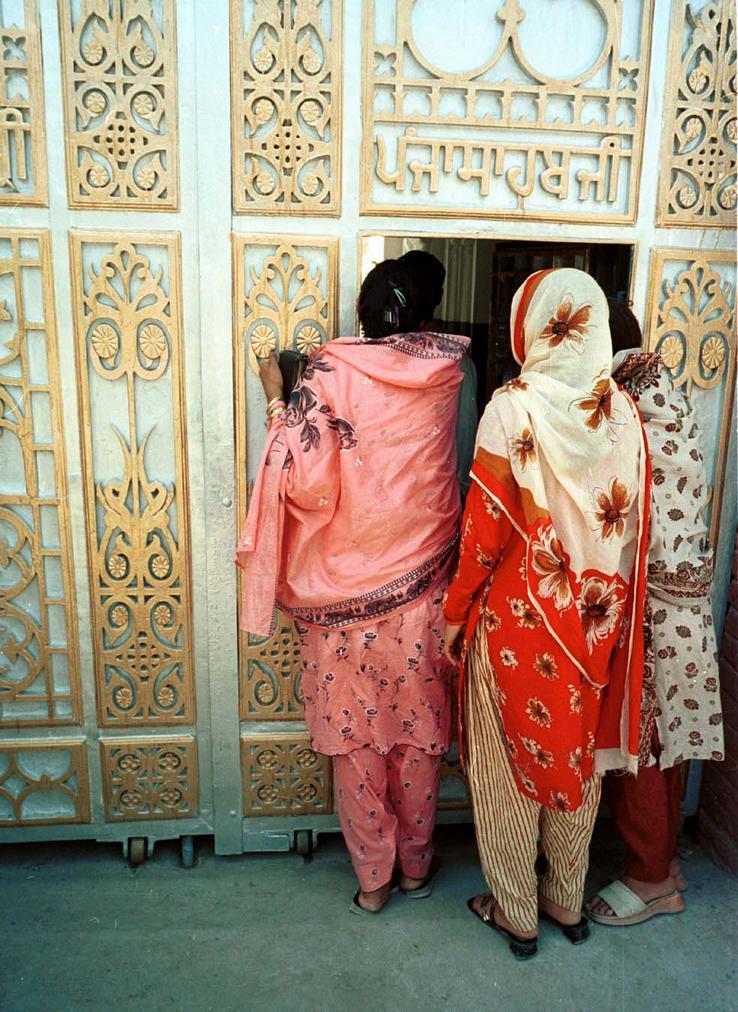 I walked away from our panel with mixed feelings. On the one hand – how exhilarating to sit in a room full of South Asian men and women and put a spotlight on the thoughts and experiences of Sikh women! I tried to remember when I ever sat in a room like that and spent two hours or more talking about what it means to be a Sikh woman and the importance of that in my life – never mind the validation by others I barely knew or had just met. The fact that this space was created at all was enough to leave me feeling full, and bursting with the need to create more such spaces and conversations.
I walked away from our panel with mixed feelings. On the one hand – how exhilarating to sit in a room full of South Asian men and women and put a spotlight on the thoughts and experiences of Sikh women! I tried to remember when I ever sat in a room like that and spent two hours or more talking about what it means to be a Sikh woman and the importance of that in my life – never mind the validation by others I barely knew or had just met. The fact that this space was created at all was enough to leave me feeling full, and bursting with the need to create more such spaces and conversations.
On the other hand, I realized, from some of the questions asked, that we are just at the beginnings of this dialogue. I have a lot of faith in our community, because I believe that out of all the other spaces in my life, this is where an honest conversation can take place; one that not only encompasses politics and radical discourse, but spirituality, as well. For if not here, where?
Sikhi was built, in part, on challenging the status quo. The founders of the faith were outraged at the injustices of their time and spoke up for the voiceless. They took to arms for the defenseless. The other, perhaps bigger, part was the right to own one’s own relationship with god – to not entrust a middle person to interpret the word of god and to seek enlightenment from within. “Sat Nam: Truth be thy name” is one of the first teachings that resonated deeply for me. It encourages us to seek out the truth because that is where we find god. The relationship to the Divine is a deeply personal for everyone, and Sikhi acknowledges that the Almighty is neither male nor female, without image, without form. This, along with the fact that caste was rejected, and social equality upheld as a goal, allowed a gateway for all to worship as one, while owning their own spirituality.
Guest blogged by Pataka
 The intersections between Sikhism, gender issues, and academia have always been tenuous and fragile ones. As other posts on this blog have mentioned, there have been some recent pushes to democratize academic research as well as examine and undo the longstanding patriarchy which has surrounded academia in general by including discussions of gender politics as well as Sikh women scholars. For more information on SAFAR take a look at previous posts on this issue or visit their website: www.sikhfeministresearch.org .
The intersections between Sikhism, gender issues, and academia have always been tenuous and fragile ones. As other posts on this blog have mentioned, there have been some recent pushes to democratize academic research as well as examine and undo the longstanding patriarchy which has surrounded academia in general by including discussions of gender politics as well as Sikh women scholars. For more information on SAFAR take a look at previous posts on this issue or visit their website: www.sikhfeministresearch.org .
Our Journeys Conference 2011
On October 1st, 2011, SAFAR –The Sikh Feminist Research Institute will host a one-day conference entitled Our Journeys Conference 2011 at The Centre for Women’s Studies in Education (CWSE), Ontario Institute for Studies in Education of the University of Toronto (OISE), University of Toronto, Ontario, Canada.
Guest-blogged by Mewa Singh. Mewa Singh is a sevadar with the Jakara Movement.
Previously, here in The Langar Hall, there was a discussion by Navdeep Singh on an important panel discussion, held in NYC, on faith, feminism, and Sikhi. Brooklynwala had asked for a comment and report about Lalkaar 2011, and I am more than happy to oblige.
However, before getting into that, I wanted to strongly encourage our Sikh youth sangat throughout California to come to Fresno/Kerman this coming weekend for an amazing opportunity. While most Sikh organizations depend on large contributions by high-fly financiers with their own set of pre-conditions, Sikh youth organizations such as the Jakara Movement and the Sikh Activist Network do not. The Jakara Movement’s biggest donors are its own members, making small contributions and the sweat and blood of its own members that come every year to sell fireworks. This is truly grassroots, where the youth give their own labor for causes and projects they love. Check out the video, follow the facebook event page to sign up, and then click below the fold for my report on Lalkaar 20111.
Guest blogged by Adi Shakti Kaur
For as long as I can remember, I can envision the imprints of patriarchy within the Guruduaras (Sikh spaces of worship). The Guru, was more than sacred scriptures; more than a living embodiment of the ‘word’; more than a Guru, who took us from darkness to light; but a portal for us to connect to our own Divinity, a genderless form that was beyond the simple, human constructions of defining, labeling and understanding. But in the Guru’s Darbar (court of the Guru), it was brimming with gendered representations. The examples of patriarchy in Guruduaras are monolithic – every role in the Guru Darbar is dominated by men, from the giving of prashad to the katha vichar. Sikhi emerged out of a cultural, political, economic and social period that privileged the masculine gender, and of course patriarchy (as well as other hierarchical constructions).
The revolutionary stance that Sikhi took on the existing beliefs challenged all aspects of the zeitgeist during the Guru period. I articulate this now as a grown woman who has had the honour of a lifelong relationship with Sikhi, with Sikh institutions and with Sikhs, and who also has had the privilege of critically engaging in the world around her, particularly through her academic pursuits. In most Guruduaras, I have had the sacred opportunity to enter, I have been greeted by scenes staged with men occupying the privileged positions in the Guru Darbar, in the langar hall and in seva roles. When the stage is constantly set with masculine representations of Sikhs, from the physical men before me to the Gurus who established and nurtured Sikhi into its current status as a world religion, I never really considered that there was an institutional space for me, for my sister, for my mother, and any Sikh woman to occupy. And for many Sikh women that male privilege extends into their homes and extended families (thankfully there are anomalies like my parents).
As I delved further into Sikhi, I saw an opening for my feminine identity. The Gurus, starting with Guru Nanak Dev Ji, not only placed value in my sex and gendered identity, but honoured us with our everpresent Kaur title. The cultural, economic, political, and social backdrop is still patriarchy, no matter how you present the egalitarian and feminist interpretations inherent in Sikh philosophy, men were privileged, men were hyper visible and that tradition continues today in the majority of Sikh institutions (including the Guruduaras) and communities. Now that I am far removed from my childhood naïve absorption of the Sikh spaces around me, absorbing the patriarchy of my spiritual space, how do I carve out the egalitarian and feminist standpoints as a grown woman, as a mother to my daughter, so Kaurs can begin to chip away at the institutionalized patriarchal vantage position given to the masculine?
Our mothers and grandmothers would be proud. If we take a moment to pause, we’ll see the amazing mobilization that is occurring in the diaspora around Sikh women’s issues, particularly by youth. I’m not quite sure if it is a legit rise in websites or events or whether we are simply paying more attention to the topic. Regardless, it is clear that there are now more forums and platforms for discussion cultivating the need for women (and men!) to come together and address issues affecting Half the Sky. This post will give a round-up of some amazing work that is happening in our community, bringing together our qaum to discuss important issues affecting Sikh women.
 {Kaurista} It is clear that Sikh women, like all women around the world, value an open space to discuss issues that directly impact us. Whether it is conversations about clothes, hair, identity or our activism – there needs to exist a space that is catered to providing Sikh girls and women with a sense of unity. This type of comraderie cannot be understated – it impacts an individual’s self esteem and confidence in a substantial way. With the launch of Kaurista.com and the immediate posting of the link all over Facebook, it is hard not to notice how much support there is for this type of forum. Kaurista provides conversations on six different topics including, Lifestyle, Style & Beauty, Family, Inspiration and Health & Wellness. One of my favourite sections of the website is “Ask Kaurista” where questions related to wanting to marry a sardar, going to prom, or overcoming alcohol abuse are answered. The site is not only aimed at Sikh girls. In fact, it actively includes Sikh men in discussions – and perhaps the hope is that through these types of discussions, Sikh men will value how truly dynamic Sikh women are!
{Kaurista} It is clear that Sikh women, like all women around the world, value an open space to discuss issues that directly impact us. Whether it is conversations about clothes, hair, identity or our activism – there needs to exist a space that is catered to providing Sikh girls and women with a sense of unity. This type of comraderie cannot be understated – it impacts an individual’s self esteem and confidence in a substantial way. With the launch of Kaurista.com and the immediate posting of the link all over Facebook, it is hard not to notice how much support there is for this type of forum. Kaurista provides conversations on six different topics including, Lifestyle, Style & Beauty, Family, Inspiration and Health & Wellness. One of my favourite sections of the website is “Ask Kaurista” where questions related to wanting to marry a sardar, going to prom, or overcoming alcohol abuse are answered. The site is not only aimed at Sikh girls. In fact, it actively includes Sikh men in discussions – and perhaps the hope is that through these types of discussions, Sikh men will value how truly dynamic Sikh women are!
{HERSTORY}
The controversial new French law that bans Muslim women from wearing the niqab, or full-face veil, went into effect today and was met with resistance in Paris. The New York Times reports:
The police detained two fully veiled women at a small protest outside the Notre Dame cathedral in central Paris, where demonstrators were easily outnumbered by police officers and journalists. But it was not clear whether the women had been held under laws forbidding unauthorized demonstrations.
French authorities estimate that less than 2,000 women in the entire country even wear the niqab, in a country of nearly 63 million. The NYT article continues:
The ban also applies to foreigners visiting France… Violators may be punished with a fine of 150 euros, equivalent to $215. But people forcing others to cover their faces are subject to much stiffer punishments, including a maximum 12 months in prison and a fine of 30,000 euros, equivalent to more than $42,000, or twice that amount if the person forced to cover their face is a minor.
I’ve argued before that France’s so-called attempts at “liberating” Muslim women in reality perpetuates racist and assimilationist notions of national identity. Some Muslims in France are organizing to challenge the law. One wealthy property developer has set aside some $2.8 million to help women fight the ban and is encouraging women to wear the niqab in the streets as a form of civil disobedience. (Check out this video of a French Muslim woman taking a train to Paris today wearing her niqab)
Guest blogged by Tarnjit Kaur
This essay was written as an introduction to ‘Sikhism and Gender Equality: Where do you See Yourself?,’ an event to be held in Ontario Saturday, April 2nd at 6 pm. All are welcome to attend.
Motivated by the empowering message of Sikh theology, Sikhi, Sikh history is replete with struggles against all forms of oppression, to protect religious freedoms, human rights and in the pursuit of self-determination. Although an expression often confined to an interpretation of Christianity, I have always thought of Sikh theology as a form of liberation theology: a theology that liberates in the here and now from social, political and economic injustices. It is from this perspective that I ask whether if a Sikh thealogy [1], that is a Sikh feminist theology, has political and social utility in advancing the cause for gender equality within the Sikh communities [2].
I argue that women’s oppression due to patriarchy is compounded by colonial factors and that the disconnect between the practise and theory of Sikhi is entrenched in socio-economic and political inequities. It is therefore seriously questionable whether there is any political utility in the efforts to reclaim the ”feminine voice” or the feminist nature of Sikh scripture as subscribed by Sikh thealogy [3]. I further ask how can gender equality be achieved? Does Sikhi empower women because of its emphasis on traditional gender roles and femininity? Or does Sikhi advocate that men should no longer exploit their own privilege arising from their status as men? Or are there clear messages of gender egalitarianism promoting gender equality? These are areas of Sikh thealogy that are pregnant for research, scriptural analysis and historical investigation and are part of a larger on-going work both within the academic sphere and by grass-roots Sikh organizations.
Today, March 8th, is the 100th annual International Women’s Day!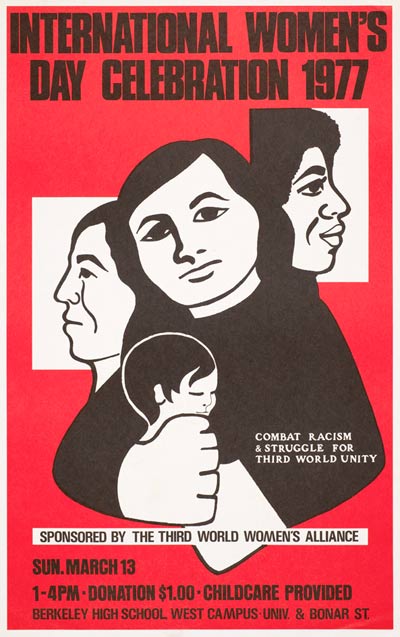 This year’s theme is “Equal access to education, training and science and technology: Pathway to decent work for women.” The first International Women’s Day was celebrated in 1911 in Austria, Denmark, Germany, and Switzerland, and is the brainchild of Clara Zetkin, a leader in the Social Democratic party in Germany, who fought for a space where women could press for their demands. This day is a celebration of the ability for women and men use our voices to advance gender equality, and the need.
This year’s theme is “Equal access to education, training and science and technology: Pathway to decent work for women.” The first International Women’s Day was celebrated in 1911 in Austria, Denmark, Germany, and Switzerland, and is the brainchild of Clara Zetkin, a leader in the Social Democratic party in Germany, who fought for a space where women could press for their demands. This day is a celebration of the ability for women and men use our voices to advance gender equality, and the need.
Gender equality has been central to Sikh social, economic, and political life since the time of the Sikh Gurus. Bebe Nanaki was the first Sikh in history to recognize Nanak as her Guru. Under Guru Amar Das Ji women were central to Sikh administrative manji system. The women of Meer Mannus prison endured extreme forms of torture and watched their children slain before their eyes but stood strong against the corrupt and brute governor of Lahore and his compatriot Kaura Mal. Fearless women warriors like Mai Bhag Kaur, Bibi Baghel Kaur, Bibi Daler Kaur stood on the frontlines of the Khalsa fauj to defend the marginalized and oppressed against authoritarian rule. Today we stand with brave Sikh women of the past and present, Mata Khivi Ji, Bibi Amrao Ji, Bibi Bhani Ji, Mata Gujri Ji, Mata Sahib Kaur, and Bibi Harnam Kaur, whose contributions to Sikhism must not fall into the shadows of Sikh religious, social, and political life as it would go against our own doctrine and values.
Please take minute on watch the clip below by three brave Sikh sisters of today willing to uphold the vision of Nanak with strength and courage. Let’s use this day to reflect on what we can do to move this community to the front lines of the Sikh vision for gender equality. #IWD in solidarity.

Guest blogged by Ajaib Kaur
Amrita (Ami) Kaur Dang’s sound often is described as a “blend” of the classical (traditional) and the experimental (non-traditional). Tossing together her North Indian vocal training with impressive sitar skills, she playfully builds collages of inquiry. Also creating the feel of a fireside gathering for trans-national, digital, post-modern sound to question everything. While a blend or an intersection might be an easier way to describe Amrita’s style to a western audience, I find her sound to be an embodiment of the everyday Sikh experience.
Click here to listen to her track “Strange Community.”
The mesmerizing loops and samples, of each track on Amrita’s full length debut album “Hukam” capture the repetitive daily dance we each participate in. Within each track there are varying sensibilities of bargaining, or even resignation, but often vigor and passion that all listeners can relate to.
The French government is at it again. France’s lower house just passed a law that would m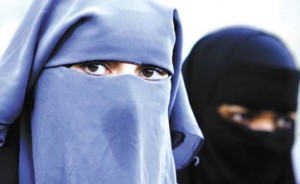 ake it illegal for women to wear the full Islamic veil (burqa or niqab) in public. It would fine women 150 euros for not complying. Sundari posted on this issue back in February, and now this attack on religious freedom has come one step closer to being the law of the land as the bill passed 335 to 1 in the National Assembly this week. The bill would have to be ratified in September by the Senate to become law.
ake it illegal for women to wear the full Islamic veil (burqa or niqab) in public. It would fine women 150 euros for not complying. Sundari posted on this issue back in February, and now this attack on religious freedom has come one step closer to being the law of the land as the bill passed 335 to 1 in the National Assembly this week. The bill would have to be ratified in September by the Senate to become law.
Proponents of the law say the National Assembly vote is a victory for democracy and French Values. Justice Minister Michele Alliot-Marie stated it was a victory for, “Values of freedom against all the oppressions which try to humiliate individuals; values of equality between men and women, against those who push for inequality and injustice.”
What about the value to practice your religion freely and express your identity (religious or otherwise) through what you wear? Madeline Bunting, in a great column in the UK’s Guardian today, stated: “Women wearing the skimpiest of mini-skirts sit down on buses next to other women in saris, business suits, salwar kameez. None of these cultural codes expressed in dress are regarded as the business of the state. Nor should they be.”
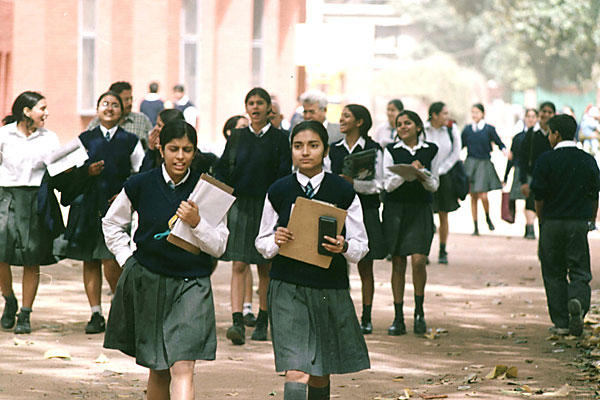 As communities around the world celebrated International Women’s Day yesterday, there were several interesting articles discussing the role of women in the world. Nicholas Kristof wrote about Three Proven Steps to Advance the World’s Women (education, micronutrients, and helping women start businesses). Another article talked about The World’s Best Countries for Women. The Christian Science Monitor discussed Gender Selection – an issue which we have often dialogued about here on TLH. The article talks about the repercussions of sex selective abortion – specifically, the gender imbalance leading to fewer women available to be wives.
As communities around the world celebrated International Women’s Day yesterday, there were several interesting articles discussing the role of women in the world. Nicholas Kristof wrote about Three Proven Steps to Advance the World’s Women (education, micronutrients, and helping women start businesses). Another article talked about The World’s Best Countries for Women. The Christian Science Monitor discussed Gender Selection – an issue which we have often dialogued about here on TLH. The article talks about the repercussions of sex selective abortion – specifically, the gender imbalance leading to fewer women available to be wives.
Villagers here say that the dearth of females has already had a direct effect on dowry customs: Dowries are getting smaller or disappearing altogether; instead, the onus is increasingly on young men to provide well for their future brides… Baljeet Singh, a 37-year-old truck driver, says he began to despair of finding a local wife once he turned 26. Men in this village, where most are farmers, consider it ideal to wed between 20 and 25. “I’m a van driver, I don’t have many prospects, and it seems that you have to have a very good job to get a bride these days,” he says. So last year, Mr Singh used his life savings to marry a 16-year-old Muslim girl from Assam; though village rumors have it that Sonu Khutum is an illegal immigrant from Bangladesh. She is happy to be living in a predominantly Hindu village, she says, joggling the couple’s 7-month-old baby girl on her hip. But lonely bachelors’ new quick fix, buying brides from impoverished parts of India, seems likely to do little to enhance the status of women. [link]
International Women’s Day is celebrated on March 8th each year and is a major day of global celebration for the economic, political and social achievements of women. We have previously posted about well known examples of women in our history who have made huge contributions to Sikhi. Perhaps on this day we can take the time to continue recognizing the numerous Sikh women who stood alongside Sikh men to help our qaum. I recently read about twenty Sikh women in a document titled, “Noble and Brave Sikh Women” by Sawan Singh. The author writes,
Bibi Rajinder Kaur and Bibi Sahib Kaur both belonged to the royal family of Patiala state. Their bravery in the battlefields and their skills in administration saved the state from being ruined. Mata Kishan Kaur and Bibi Balbir Kaur took part and suffered in the Akali movement for the control of Gurdwaras. Bibi Balbir Kaur even sacrificed her own life and that of her innocent child in this movement. Bibi Harnam Kaur has done wonders to spread female education among the Sikh women a hundred years ago. Mai Bhag Kaur has proved that Sikh women can lead and organize the Sikh men and win battles. Women martyrs of Shahid Gunj of Lahore like Bhghel Kaur cannot be found in the literature of many religions. Bibi Sharan Kaur and Bibi Shamsher Kaur have proved their skills in the battlefield and in administration. Bibi Anoop Kaur, Bibi Shushil Kaur, Bibi Harsharan Kaur, Bibi Basan Lata and Bibi Nirbhay Kaur have faced odds and sacrificed their lives to save their honor and faith.
The document is a great starting point to begin learning about the immense history of Sikh women that often goes untold. Are there any events in your community being planned for International Women’s Day? How do we, in general, recognize the contributions of women in Sikh history?
Amarjit Kaur, 39, was critically shot on Wednesday afternoon in Vallejo, California as she sold ice cream out of an ice cream truck near a school. The Bay Area television news reported last night that police believe the reason for the shooting was two fold. First it was a robbery by a 15-year male. Secondly, Kaur’s inability to understand that the English-speaking 15-year old was asking for money caused him to shoot her out of frustration and anger.
As a widowed mother of three and a recent immigrant to the United States, Kaur’s case highlights the struggle that immigrant woman go through to support their families. Her strength to sell ice cream out of a truck while not completely understanding English shows perseverance during adversity but also highlights the risk new immigrants take to build lives for themselves and their families in the United States.
You would imagine that selling ice cream to primarily children would not be high risk. However, Harish Joshi reported that he was held-up twice while operating an ice cream truck in Richmond (California Bay Area).
Kuldeep Malhan, Kaur’s brother-in-law said a fund has been set-up to help support the family at Bank of America, account No. 488019845001. Please donate to help with Kaur’s medical bills and other living expenses while she is unable to work because of her injuries.
Happy Lohri! 
Lohri is celebrated around January 13th every year. In Punjab, it marks the beginning of the harshest part of winter. Here’s what you need to get started with your celebration: a giant bonfire, popcorn, sweets, and songs about Dulha Bhatti, a robber who helped the poor.
Lohri is usually celebrated in the outdoors by friends and family who get together and have a bonfire in the evening. Lohri signifies onset of intense winter in Punjab and surrounding areas. Cold weather is good for wheat hence farmers celebrate Lohri so that their crops lead to a good harvest.
During the day, children go from door to door singing folk songs in praise of Dulha Bhatti, a thief in folklore who helps the poor and fights for their rights. These children are given sweets and savories, and occasionally, money. These collections are known as Lohri, and they are distributed at night during the festival. Some may be offered to the sacred fire. Peanuts, popcorn and other food items are also thrown into the fire as an offering to the God of Fire, Agni. [wikipedia]
Usually, in Punjab, families have an especially large Lohri celebration if a boy has been born in the family in the prior year. We’re talking DJs, catered food, and dancing all night in the streets (at least in the city).
This year, you can make Lohri special by donating to Ladoos: Pink & Blue.
Religions derive their power and popularity in part from the ethical compass they offer. So why do so many faiths help perpetuate something that most of us regard as profoundly unethical: the oppression of women? [NYT]
An op-ed piece in the NYT, by the notable Nicholas Kristof, looks at the way many religions perpetuate and sanctify the oppression of women. He discusses that many abuses, such as mass rapes, arise out of a social context in which women are considered second-class citizens and argues that this social context is something religions have helped shape rather than fought hard to change. Kristof wrote this op-ed after listening to former President Jimmy Carter’s speech to the Parliament of the World’s Religions in Australia last month.
Mr. Carter, who sees religion as one of the “basic causes of the violation of women’s rights,” is a member of The Elders, a small council of retired leaders brought together by Nelson Mandela. The Elders are focusing on the role of religion in oppressing women, and they have issued a joint statement calling on religious leaders to “change all discriminatory practices within their own religions and traditions.”
